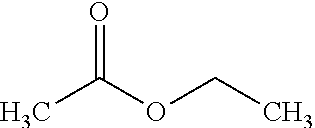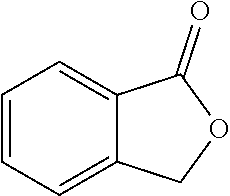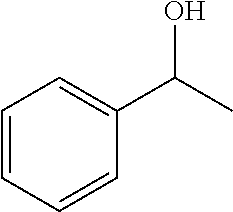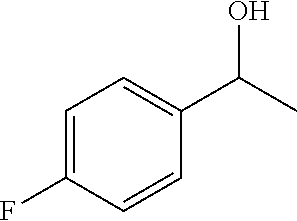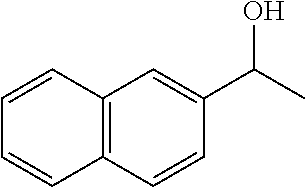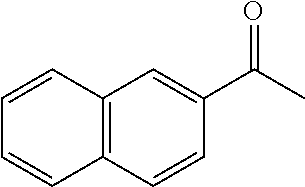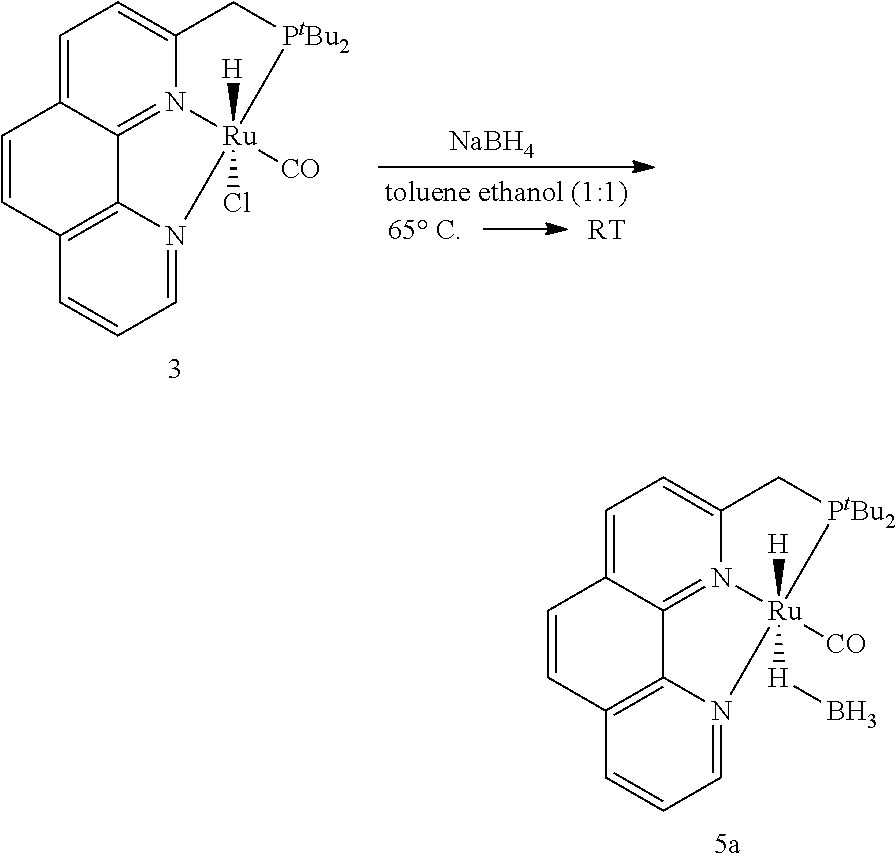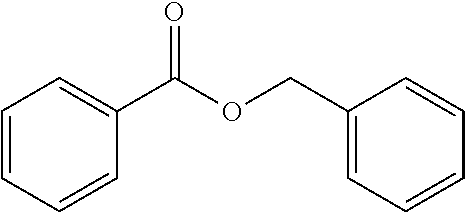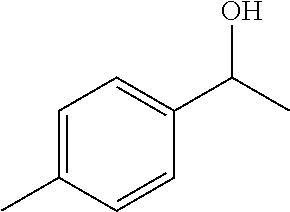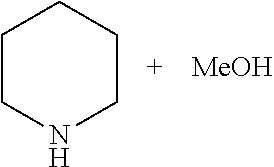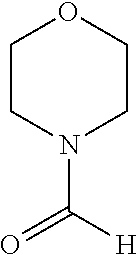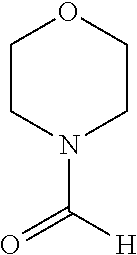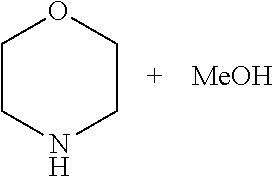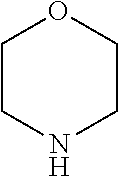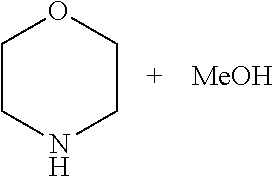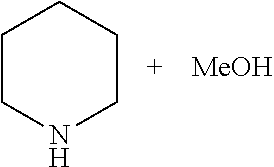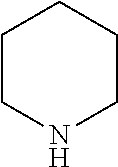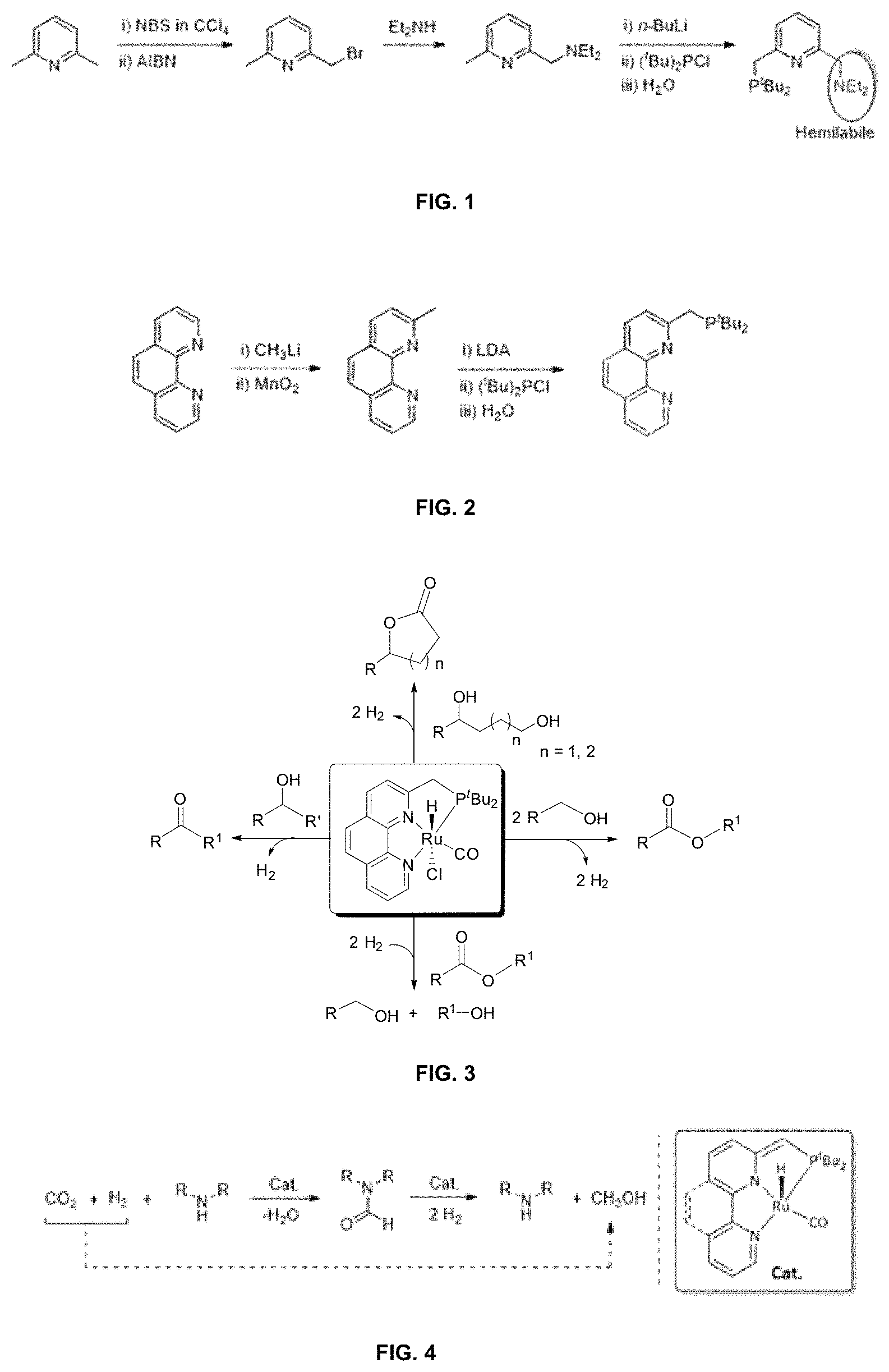Phenanthroline based pincer complexes useful as catalysts for the preparation of methanol from carbondioxide
Balaraman , et al. Sep
U.S. patent number 10,758,896 [Application Number 16/507,307] was granted by the patent office on 2020-09-01 for phenanthroline based pincer complexes useful as catalysts for the preparation of methanol from carbondioxide. This patent grant is currently assigned to COUNCIL OF SCIENTIFIC & INDUSTRIAL RESEARCH. The grantee listed for this patent is Council of Scientific and Industrial Research. Invention is credited to Ekambaram Balaraman, Garima Jaiswal, Vinod Gokulkrishna Landge, Siba Prasad Midya, Manoj Kumar Sahoo.





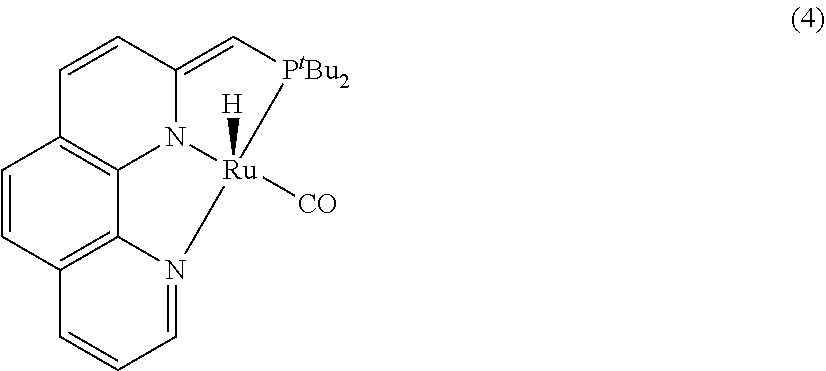






View All Diagrams
| United States Patent | 10,758,896 |
| Balaraman , et al. | September 1, 2020 |
Phenanthroline based pincer complexes useful as catalysts for the preparation of methanol from carbondioxide
Abstract
The present invention relates to a novel phenonthroline based pincer complexes and process for preparation thereof. The present invention also provides a one pot process for the conversion of carbon dioxide to methanol in the presence of a molecularly defined pincer-type single-site Ru-catalyst and secondary amine. Further the present invention provides the use of phenonthroline based pincer complexes for the esterification of alcohols and hydrogenation of esters under mild conditions.
| Inventors: | Balaraman; Ekambaram (Maharashtra, IN), Landge; Vinod Gokulkrishna (Maharashtra, IN), Midya; Siba Prasad (Maharashtra, IN), Sahoo; Manoj Kumar (Maharashtra, IN), Jaiswal; Garima (Maharashtra, IN) | ||||||||||
|---|---|---|---|---|---|---|---|---|---|---|---|
| Applicant: |
|
||||||||||
| Assignee: | COUNCIL OF SCIENTIFIC &
INDUSTRIAL RESEARCH (New Delhi, IN) |
||||||||||
| Family ID: | 55854763 | ||||||||||
| Appl. No.: | 16/507,307 | ||||||||||
| Filed: | July 10, 2019 |
Prior Publication Data
| Document Identifier | Publication Date | |
|---|---|---|
| US 20190329232 A1 | Oct 31, 2019 | |
Related U.S. Patent Documents
| Application Number | Filing Date | Patent Number | Issue Date | ||
|---|---|---|---|---|---|
| 15549827 | 10449529 | ||||
| PCT/IN2016/050050 | Feb 10, 2016 | ||||
Foreign Application Priority Data
| Feb 10, 2015 [IN] | 358/DEL/2015 | |||
| Feb 13, 2015 [IN] | 417/DEL/2015 | |||
| Current U.S. Class: | 1/1 |
| Current CPC Class: | B01J 31/189 (20130101); B01J 31/2404 (20130101); B01J 31/183 (20130101); B01J 31/2447 (20130101); C07F 15/0046 (20130101); B01J 31/20 (20130101); B01J 31/1815 (20130101); B01J 2231/648 (20130101); B01J 2231/643 (20130101); B01J 2531/821 (20130101); B01J 2231/763 (20130101); B01J 2531/0244 (20130101) |
| Current International Class: | B01J 31/18 (20060101); B01J 31/24 (20060101); B01J 31/20 (20060101); C07F 15/00 (20060101) |
References Cited [Referenced By]
U.S. Patent Documents
| 2009/0112005 | April 2009 | Milstein et al. |
| 2013/0281664 | October 2013 | Milstein et al. |
| 103980317 | Aug 2014 | CN | |||
| 2006/106484 | Oct 2006 | WO | |||
| 2012/052996 | Apr 2012 | WO | |||
| 2012/052996 | Apr 2012 | WO | |||
Other References
|
International Search Report and Written Opinion dated Jul. 12, 2016, from the corresponding PCT/IN2016/050050. cited by applicant . International International Preliminary Report on Patentability dated Mar. 21, 2017, from the corresponding PCT/IN2016/050050. cited by applicant . Pierre H. Dixneuf, "Bifunctional catalysis: A bridge from CO2 to methanol" published in Nature Chemistry, Nature Publishing Group, GB, vol. 3, Aug. 1, 2011, pp. 578-579, XP009150767, ISSN: 1755-4330, figure 1, the whole document. cited by applicant . Chelsea A. Huff et al., "Cascade catalysis for the homogeneous hydrogenation of CO2 to methanol", published in Journal of American Chemical Society, vol. 133, No. 45, Oct. 26, 2011, pp. 18122-18125, XP055023110, ISSN: 0002-7863, D01: 10.1021/ja208760j Scheme 2; table 1; compounds C-1, C-2. cited by applicant . Balaraman, E, et al, "Efficient hydrogenation of organic carbonates, carbamates and formates indicates alternative routes to methanol based on CO2 and CO" published in Nature Chemistry, 2011, vol., No. 8, Jan. 1, 2011, pp. 609-614, XP009150768, ISSN: 1755-4330, figures 1, 4; compounds 1-4, abstract. cited by applicant . Notice of Allowance dated Apr. 9, 2019, from U.S. Appl. No. 15/549,827, 46 sheets. cited by applicant . Balaraman et al. (JACS, 132, 16756-16758 (Year: 2010). cited by applicant . Notice of Allowance dated Apr. 25, 2019, from U.S. Appl. No. 15/549,827, 10 sheets. cited by applicant . Notice of Allowance dated Sep. 26, 2019, from U.S. Appl. No. 15/549,827, 11 sheets. cited by applicant . Adriana Valore et al., "Novel ruthenium(II) complexes with substituted 1,10-phenanthroline or 4,5-diazafluorene linked to a fullerene as highly active second order NLO chromophores" published in Dalton Trans., 2010,39, 10314-10318. cited by applicant . Langer et al., "Stepwise Metal--Ligand Cooperation by a Reversible Aromatization/Deconjugation Sequence in Ruthenium Complexes with a Tetradentate Phenanthroline-Based Ligand" published in Chemistry, 2013;19(10), pp. 3407-3414. cited by applicant . J Zhang et al., "Electron-Rich PNP- and PNN-Type Ruthenium (II) Hydrido Borohydride Pincer Complexes. Synthesis, Structure, and Catalytic Dehydrogenation of Alcohols and Hydrogenation of Esters" published in Organometallics, 2011, 30 (21), pp. 5716-5724. cited by applicant . Rigoberto Barrios-Francisco et al., "PNN Ruthenium Pincer Complexes Based on Phosphinated 2,2'Dipyridinemethane and 2,2'-Oxobispyridine. Metal-Ligand Cooperation in Cyclometalation and Catalysis" published in Organometallics, 2013, 32 (10), pp. 2973-2982. cited by applicant . Boopathy Gnanaprakasam et al., "Synthesis of Amides from Esters and Amines with Liberation of H2 under Neutral Conditions" published in J. Am. Chem. Soc., 2011, 133 (6), pp. 1682-1685. cited by applicant . Jing Zhang et al., "Facile Conversion of Alcohols into Esters and Dihydrogen Catalyzed by New Ruthenium Complexes" published in in J. am. chem. soc., 2005, 127, 10840-10841. cited by applicant . Yu-Nong Li et al., "Homogeneous hydrogenation of carbon dioxide to methanol" published in Catalysis Science & Technology, 2014, 4(6), pp. 1498-1512. cited by applicant . Sebastian Wesselbaum et al., "Hydrogenation of carbon dioxide to methanol using a homogeneous ruthenium-Triphos catalyst: from mechanistic investigations to multiphase catalysis" published in Chemical Science, 2015, 6, 693-704. cited by applicant . Sebastian Wesselbaum et al., "Hydrogenation of carbon dioxide to methanol by using a homogeneous ruthenium-phosphine catalyst" published in Angewandte Chemie International Edition, 2012, 51(30):7499-7502. cited by applicant . Chelsea Ariane Huff, "Cascade catalysis for the homogeneous hydrogenation of carbon dioxide to methanol" published in Journal of the American Chemical Society, 2011, 133, 18122-18125. cited by applicant . Dr. Ekambaram Balaraman et al., "Unprecedented catalytic hydrogenation of urea derivatives to amines and methanol", published in Angewandte Chemie International Edition, 2011, 50(49):11702-11705. cited by applicant . Jotheeswari Kothandaraman et al., "Conversion of CO2 from air into methanol using a polyamine and a homogeneous ruthenium catalyst", published in Journal of American Chemical Society, 2015, pp. 778-781. cited by applicant . Huang F et al.,"How does the nickel pincer complex catalyze the conversion of CO2 to a methanol derivative? A computational mechanistic study", published in Inorganic Chemistry, 2011, 18;50(8), pp. 3816-3825. cited by applicant . Ekambram Balaraman, "Efficient hydrogenation of organic carbonates, carbamates and formates indicates alternative routes to methanol based on CO2 and CO", published in Nature Chemistry, vol. 3, Aug. 2011, www.nature.com/naturechemistry, pp. 609-614. cited by applicant . Pierre H. Dixneuf, "A bridge from CO2 to methanol", Nature Chemistry, vol. 3, Aug. 2011, www.nature.com/naturechemistry, pp. 578-579. cited by applicant. |
Primary Examiner: Mayes; Melvin C.
Assistant Examiner: Qian; Yun
Attorney, Agent or Firm: Katten Muchin Rosenman LLP
Claims
The invention claimed is:
1. A process for the preparation of methanol from carbon dioxide catalysed by phenanthroline complex pincer complexes, comprising the steps of: i. mixing a catalyst and a secondary amine in a ratio of (1:500) in tetrahydrofuran to obtain a solution; ii. adding potassium tert-butoxide to the solution obtained in step (a) to obtain a solution; iii. pressurizing the solution as obtained in step (ii) with carbon dioxide at 10 atmosphere followed by H.sub.2 atmosphere at 30-40 atm to obtain a solution; iv. heating the solution as obtained in step (iii) at 110-120.degree. C. and stirring for 12-14 hrs to obtain a solution; v. removing excess gases from the solution as obtained in step (iv) to obtain N-formylated product of secondary amine; vi. adding the catalyst and potassium tert-butoxide to the N-formylated product of secondary amine as obtained in step (v) to obtain solution (vi); vii. pressurizing the solution as obtained in step (vi) with H.sub.2 at 40-45 atmosphere followed by heating the solution at 110-120.degree. C. and stirring for 18-20 hrs to obtain methanol and recyclable secondary amine, wherein the catalyst used in step (i) and step (vi) is selected from HCl(CO)Ru(Phen-(tBu)PNN) (3); H(CO)Ru-(Phen-(tBu)PNN) (4); and H(CO)Ru(.eta.IBH4)(Phen-(tBu)PNN) (5) ##STR00168##
2. The process as claimed in claim 1, wherein the secondary amine used in step (i) is selected from A or B ##STR00169## wherein; X is selected from the group consisting of NH, CH.sub.2, and O, R.sup.1 and R.sup.2 are the same or different and are selected from the group consisting of linear alkyl, branched alkyl, substituted or unsubstituted cyclo, wherein said cyclo is optionally up to a seven membered cyclo, wherein said substituted cyclo is mono, di, tri or tetra substituted and said substitution is independently and selected from the group consisting of linear alkyl, branched alkyl, substituted aryl, cycloalkyl, alkylaryl, alkylheterocyclyl, alkylheteroaryl, halogen, trifluoromethyl, nitro, alkoxy, dialkylamino, diarylamino, and --SR, wherein R is alkyl, cycloalkyl, or aryl, which is optionally further substituted with heterocyclyl, heteroaryl, alkylcycloalkyl, alkylaryl, alkylheterocyclyl, or alkylheteroaryl, cycloalkyl, substituted or unsubstituted aryl, wherein said substituted aryl is mono, di, tri or tetra substituted, heterocyclyl, and heteroaryl.
Description
FIELD OF THE INVENTION
The present invention relates to phenonthroline based pincer complex of formula (I) and process for preparation thereof. Particularly the present invention relates to use of phenonthroline based pincer complex of formula (I) as catalyst for the esterification of alcohols and hydrogenation of esters including lactones under mild conditions. More particularly the present invention relates to a one pot process for the conversion of carbon dioxide to methanol in the presence of a pincer based catalyst and a secondary amine wherein the secondary amine is recovered and recycled.
BACKGROUND OF THE INVENTION
In the state-of-the-art catalysis, design and development of new catalytic systems for selective organic transformations is of significant interest, though very challenging. Particularly, alternative `green` approaches to traditionally employing stoichiometric reagents and/or harsh conditions in industrially important reactions are extremely essential with regard to both energy and environment. The direct conversion of alcohols to value-added products and hydrogenation of carbonyl compounds to the corresponding alcohols and/or amines are benchmark reactions. Alcohol esterification is one of the most important reactions in synthetic organic chemistry and has potential applications including in fragrance, polymer, and pharmaceutical industries. The reaction is typically carried-out by coupling of activated carboxylic acid derivatives with an alcohol and produce stoichiometric acid waste. An ideal and alternative approach would be catalytic acceptorless dehydrogenation of alcohols with the evolution of molecular hydrogen, but homogeneous systems capable of catalyzing dehydrogenation of alcohols are relatively rare.
Catalytic hydrogenation of carboxylic acid derivatives, particularly esters with hydrogen gas, provides a promising alternative approach to conventional reduction methods. The operational simplicity, `green` approach and economic viability are additional advantages and make this method much more attractive. In industry, this process is carried out under heterogeneous conditions using catalysts such as copper chromite at high pressure (200-300 atm) and temperatures (200-300.degree. C.).
Article titled "Novel ruthenium(II) complexes with substituted 1,10-phenanthroline or 4,5-diazafluorene linked to a fullerene as highly active second order NLO chromophores" by Adriana Valore et al. published in Dalton Trans., 2010, 39, 10314-10318 reports Ru(II) complexes with substituted 1,10-phenanthroline or 4,5-diazafluorene.
Article titled "Stepwise Metal-Ligand Cooperation by a Reversible Aromatization/Deconjugation Sequence in Ruthenium Complexes with a Tetradentate Phenanthroline-Based Ligand" by Langer et al. published in Chemistry, 2013; 19(10), pp 3407-14 reports synthesis and reactivity of ruthenium complexes containing the tetradentate phenanthroline-based phosphine ligand 2,9-bis((di-tert-butylphosphino)methyl)-1,10-phenanthroline (PPhenP).
Chinese patent application no. 103980317 discloses a dipyridyl tetradentate ligand ruthenium complex as well as a preparation method of the complex and application of the complex to a reaction for hydrogenating ester compounds into alcohol compounds.
US patent application no. 20130281664 discloses novel ruthenium catalysts and related borohydride complexes, and the use of such catalysts for (1) hydrogenation of amides (including polyamides) to alcohols and amines; (2) preparing amides from alcohols with amines (including the preparation of polyamides (e.g., polypeptides) by reacting dialcohols and diamines and/or by polymerization of amino alcohols); (3) hydrogenation of esters to alcohols (including hydrogenation of cyclic esters (lactones) or cyclic di-esters (di-lactones) or polyesters); (4) hydrogenation of organic carbonates (including polycarbonates) to alcohols and hydrogenation of carbamates (including polycarbamates) or urea derivatives to alcohols and amines; (5) dehydrogenative coupling of alcohols to esters; (6) hydrogenation of secondary alcohols to ketones.
Article titled "Electron-Rich PNP- and PNN-Type Ruthenium (II) Hydrido Borohydride Pincer Complexes. Synthesis, Structure, and Catalytic Dehydrogenation of Alcohols and Hydrogenation of Esters" By J Zhang et al. published in Organometallics, 2011, 30 (21), pp 5716-5724 reports Electron-rich PNP- and PNN-type ruthenium(II) hydrido borohydride pincer complexes, [RuH(BH.sub.4)(tBu-PNP)] (tBu-PNP=(2,6-bis(di-tert-butylphosphinomethyl)pyridine) (5) and [RuH(BH.sub.4)(tBu-PNN)] (tBu-PNN=2-di-tert-butylphosphinomethyl-6-diethylaminomethylpyridine) (6), prepared from their corresponding N.sub.2-bridged dinuclear Ru(II) complexes [(tBu-PNP)RuCl.sub.2]2(.mu.-N.sub.2) (3) and [(tBu-PNN)RuCl.sub.2]2(.mu.-N.sub.2) (4), respectively.
Article titled "PNN Ruthenium Pincer Complexes Based on Phosphinated 2,2'-Dipyridinemethane and 2,2'-Oxobispyridine. Metal-Ligand Cooperation in Cyclometalation and Catalysis" By Rigoberto Barrios-Francisco et al. published in Organometallics, 2013, 32 (10), pp 2973-2982 reports synthesis of novel PNN ruthenium pincer complexes based on 2,2'-dipyridinemethane phosphine derivatives, as well as on 2,2'-oxobispyridine phosphine ligands, and their reactivity toward dearomatization and cyclometalation.
Article titled "Synthesis of Amides from Esters and Amines with Liberation of H.sub.2 under Neutral Conditions" by Boopathy Gnanaprakasam et al. published in J. Am. Chem. Soc., 2011, 133 (6), pp 1682-1685 reports efficient synthesis of amides directly from esters and amines is achieved under mild, neutral conditions with the liberation of molecular hydrogen which is homogeneously catalyzed under neutral conditions by a dearomatized Ru-pincer PNN complex.
PCT application no. 2006106484A1 discloses catalytic hydrogenation and use of Ru complexes with tetradentate ligands, having at least one amino or imino coordinating group and at least one phosphino coordinating group, in hydrogenation processes for the reduction of esters or lactones into the corresponding alcohol or diol respectively.
Article titled "Facile Conversion of Alcohols into Esters and Dihydrogen Catalyzed by New Ruthenium Complexes" by Jing Zhang et al. published in in J. Am. Chem. Soc., 2005, 127, 10840-10841 reports Ru(II) hydride complexes based on electron rich PNP and PNN ligands catalyze alcohol dehydrogenation to esters.
Heterogeneous catalytic systems for direct hydrogenation of CO.sub.2 to methanol require high temperature and pressure and often selectivity is the major issue. Owing to rational tuning of reactivity and selectivity of homogeneous catalysts much attention has been paid for their utility in selective hydrogenation of CO.sub.2. In recent years, pincer ligands which bind to metal centers in a tri-dentate, meridional fashion have drawn much attention and serve as excellent ligands, due to stability and variability of the generated metal-ligand framework. The donor/acceptor ability at both the central and adjacent side-arm positions of the pincer ligands can be controllable. And both the electronic and steric environment around the metal center can also be tunable.
Article titled "Carbon dioxide hydrogenation to methanol at low pressure and temperature" by Bill Alain published in EPFL, 1998 reports the conversion of CO.sub.2 with hydrogen to methanol is investigated in dielectric-barrier discharges with and without catalysts at low temperatures (.ltoreq.100.degree. C.) and pressures (.ltoreq.10 bar).
Article titled "Bifunctional catalysis: A bridge from CO.sub.2 to methanol" by Pierre H. Dixneuf published in Nature Chemistry, 2011, 3, pp 578-579 reports methanol can be produced via the hydrogenation of carbonates and carbamates using a pincer ruthenium(II) catalyst.
Article titled "Homogeneous hydrogenation of carbon dioxide to methanol" by Yu-Nong Li et al. published in Catalysis Science & Technology, 2014, 4(6), pp 1498-1512 reports metal complexes and organocatalysts for CO.sub.2 hydrogenation to methanol have been developed along with the reaction mechanistic insight. Understanding the interaction of active catalytic species with CO.sub.2 or hydrogen could account for development of efficient homogeneous catalysts.
Article titled "Hydrogenation of carbon dioxide to methanol using a homogeneous ruthenium-Triphos catalyst: from mechanistic investigations to multiphase catalysis" by Sebastian Wesselbaum et al. published in Chemical Science, 2015, 6, 693-704 reports Hydrogenation of carbon dioxide to methanol using a homogeneous ruthenium-Triphos catalyst: from mechanistic investigations to multiphase catalysis.
Article titled "Hydrogenation of carbon dioxide to methanol by using a homogeneous ruthenium-phosphine catalyst" by Sebastian Wesselbaum et al. published in Angewandte Chemie International Edition, 2012, 51(30):7499-502 reports the homogenously catalyzed hydrogenation of CO.sub.2 to methanol is achieved by using a ruthenium phosphine complex under relatively mild conditions (HNTf2=bis(trifluoromethane)sulfonimide). This is the first example of CO.sub.2 hydrogenation to methanol by using a single molecularly defined catalyst.
Article titled "Cascade hydrogenation of carbon dioxide to methanol" by Chelsea Ariane Huff published as thesis in 2014 reports use of homogeneous catalysts in tandem for the hydrogenation of CO.sub.2 to CH.sub.3OH at relatively high temperature (135.degree. C.).
Article titled "Tandem amine and ruthenium-catalyzed hydrogenation of CO.sub.2 to methanol" by Rezayee N M et al. published in Journal of American Chemical Society, 2015, 28; 137(3), pp 1028-31 reports the hydrogenation of carbon dioxide to methanol via tandem catalysis with dimethylamine and a homogeneous ruthenium complex. The dimethylamine is proposed to play a dual role in this system. It reacts directly with CO.sub.2 to produce dimethylammonium dimethylcarbamate, and it also intercepts the intermediate formic acid to generate dimethylformamide. With the appropriate selection of catalyst and reaction conditions, >95% conversion of CO.sub.2 was achieved to form a mixture of CH.sub.3OH and dimethylformamide.
Article titled "Examining ruthenium chromophores for the photochemical reduction of CO.sub.2 to methanol" by David J Boston published as thesis in 2013 reports photochemical reduction of carbon dioxide to methanol is possible using pyridine and the complex [Ru(phen).sub.2dppz](PF.sub.6).sub.2, [Ru(phen).sub.2pbtp.alpha.](PF.sub.6).sub.2, and [Ru(phen).sub.2pbtp.beta.](PF.sub.6).sub.2.
Article titled "Cascade catalysis for the homogeneous hydrogenation of CO.sub.2 to methanol" by Chelsea A. Huff et al. published in Journal of American Chemical Society, 2011, 133 (45), pp 18122-18125 reports the homogeneous hydrogenation of CO.sub.2 to CH3OH via cascade catalysis. Three different homogeneous catalysts, (PMe3).sub.4Ru(Cl)(OAc), Sc(OTf).sub.3, and (PNN)Ru(CO)(H), operate in sequence to promote this transformation.
Article titled "Efficient hydrogenation of organic carbonates, carbamates and formates indicates alternative routes to methanol based on CO.sub.2 and CO" by Balaraman E et al. published in Nature Chemistry, 2011, 3(8), pp 609-14 reports catalytic hydrogenation of organic carbonates to alcohols, and carbamates to alcohols and amines. Unprecedented homogeneously catalysed hydrogenation of organic formates to methanol has also been accomplished. The reactions are efficiently catalysed by dearomatized PNN Ru(II) pincer complexes derived from pyridine- and bipyridine-based tridentate ligands.
Article titled "Unprecedented catalytic hydrogenation of urea derivatives to amines and methanol" by Dr. Ekambaram Balaraman et al. published in Angewandte Chemie International Edition, 2011, 50(49):11702-11705 reports hydrogenation of urea derivatives to the corresponding amines and methanol is reported. The reaction is catalyzed by a bipyridine-based tridentate PNN Ru(II) pincer complex and proceeds under mild, neutral conditions using 13.6 atm of H.sub.2. A mild approach is offered for the indirect hydrogenation of CO.sub.2 to methanol as urea derivatives are available from CO.sub.2.
Article titled "Conversion of CO.sub.2 from air into methanol using a polyamine and a homogeneous ruthenium catalyst" by Jotheeswari Kothandaraman et al. published in Journal of American Chemical Society, 2015 reports a highly efficient homogeneous catalyst system for the production of CH.sub.3OH from CO.sub.2 using pentaethylenehexamine and Ru-Macho-BH (1) at 125-165.degree. C. in an ethereal solvent has been developed (initial turnover frequency=70 h.sup.-1 at 145.degree. C.).
Article titled "How does the nickel pincer complex catalyze the conversion of CO.sub.2 to a methanol derivative? A computational mechanistic study" by Huang F et al. published in Inorganic Chemistry, 2011, 18; 50(8), pp 3816-25 reports the mechanistic details of nickel-catalyzed reduction of CO.sub.2 with catecholborane (HBcat) have been studied only by DFT calculations. The nickel pincer hydride complex ({2,6-C.sub.6H.sub.3(OP(t)Bu.sub.2).sub.2}NiH.dbd.[Ni]H) has been shown to catalyze the sequential reduction from CO.sub.2 to HCOOBcat, then to CH.sub.2O, and finally to CH.sub.3OBcat.
However, there is a need in the art to develop novel catalyst for an atom-economical, environmentally benign and operationally simple synthetic process from the feedstock chemicals for the direct conversion of alcohols to esters and efficient hydrogenation of esters to alcohols under solvent-free reaction conditions.
OBJECTIVE OF THE INVENTION
The main objective of the present invention is to provide a phenanthroline based pincer complex of formula (I).
Another objective of the present invention is to provide a process for the synthesis of novel phenanthroline based pincer complex of formula (I).
Still another objective of the present invention is to provide a process for the hydrogenation and dehydrogenation reactions using phenanthroline based pincer complex of formula (I) as catalyst.
Still another objective of the present invention is to provide a one pot process for the conversion of carbon dioxide to methanol in the presence of a pincer based catalyst and a secondary amine under mild conditions with improved yield.
SUMMARY OF THE INVENTION
Accordingly the present invention provides a phenanthroline based pincer catalyst complexes of Formula (I);
##STR00001## wherein M is a noble metal, transition metal (1.sup.st, 2.sup.nd and 3.sup.rd row of elements), alkaline-earth- or rare-earth elements; Y is selected from the group consisting of phosphine (PR.sup.aR.sup.b), phosphite P(OR.sup.a)(OR.sup.b), phosphinite P(OR.sup.a)(R.sup.b), amine (NR.sup.aR.sup.b), imine, sulphide SR.sup.a, oxide OR.sup.a, sulfoxide S(O)R.sup.a, sulphone SO.sub.2R.sup.a, oxazoline, N-heterocyclic carbine, heteroaryl containing at least one heteroatom selected from nitrogen or Sulphur; L is selected from the group consisting of CO, BH.sub.3, BH.sub.2, PR.sup.aR.sup.bR.sup.c, P(OR.sup.a)(OR.sup.b)(OR.sup.c), nitrile (RCN) or isonitrile (RNC); R, R.sup.a, R.sup.b, and R.sup.c are selected from the group consisting of alkyl, cycloalkyl, aryl which may be further substituted heterocyclyl, heteroaryl, alkylcycloalkyl, alkylaryl, alkylheterocyclyl, alkylheteroaryl.
A ligand used is aromatic or dearomatic is selected from the group consisting of H, halogen, OCOR, OCOCF.sub.3, OSO.sub.2R, OSO.sub.2CF.sub.3, CN, OR, N(R).sub.2 and RS;
R.sup.1, represents hydrogen or one or two substituents wherein each such substituent is independently selected from the group consisting of alkyl (linear and branched), cycloalkyl, aryl, substituted aryl, heterocyclyl, heteroaryl, alkylcycloalkyl, alkylaryl, alkylheterocyclyl, alkylheteroaryl, halogen, triflurometyl, nitro, amide, ester (--CO.sub.2R), --OC(O)R, --OC(O)CF.sub.3, --OSO.sub.2R, --OSO.sub.2CF.sub.3) cyano, alkoxy, alkylamino (mono or di), arylamino (mono or di), --SR, an inorganic support or a polymeric moiety.
R.sup.2 and R.sup.3 form a 6 membered aromatic ring which is further substituted with one or two substituents wherein each such substituent is independently selected from the group consisting of alkyl (linear and branched), cycloalkyl, aryl, substituted aryl, heterocyclyl, heteroaryl, alkylcycloalkyl, alkylaryl, alkylheterocyclyl, alkylheteroaryl, halogen, triflurometyl, nitro, amide, ester (--CO.sub.2R), --OC(O)R, --OC(O)CF.sub.3, --OSO.sub.2R, --OSO.sub.2CF.sub.3) cyano, alkoxy, alkylamino (mono or di), arylamino (mono or di), --SR, an inorganic support or a polymeric moiety.
R.sup.3 and R.sup.4 form a six member aromatic ring which is further substituted with one or two substituents wherein each such substituent is independently selected from the group consisting of alkyl (linear and branched), cycloalkyl, aryl, substituted aryl, heterocyclyl, heteroaryl, alkylcycloalkyl, alkylaryl, alkylheterocyclyl, alkylheteroaryl, halogen, triflurometyl, nitro, amide, ester (--CO.sub.2R), --OC(O)R, --OC(O)CF.sub.3, --OSO.sub.2R, --OSO.sub.2CF.sub.3) cyano, alkoxy, alkylamino (mono or di), arylamino (mono or di), --SR, an inorganic support or a polymeric moiety.
In an embodiment present, invention provides a phenanthroline based pincer complexes of formula (I) as claimed in claim 1, wherein said complex is selected from HCl(CO)Ru(Phen-(tBu)PNN) (3), H(CO)Ru-(Phen-(tBu)PNN) (4) and H(CO)Ru(.eta.1BH4)(Phen-(tBu)PNN) (5a).
##STR00002##
In another embodiment of present invention, the said catalyst is used for hydrogenation of lactones to diols and esters to alcohols
In still another embodiment of present invention, the said catalyst is used for dehydrogenation of diols to lactones, alcohol to esters and secondary alcohols to ketones.
In yet another embodiment, present invention provides a process for the preparation of phenanthroline based pincer complexes of formula (I) as claimed in claim 1, wherein said process comprising the steps of: a) adding solution of Lithium diisopropylamide and tBuOK in suitable solvent to a solution of 2-methyl-1,10-phenanthroline (1) in ether at a temperature in the range of 0 to 5.degree. C. followed by stirring the reaction mixture for the period in the range of 30 to 40 min to obtain a solution;
##STR00003## b) adding a solution of di-tert-butylchlorophosphine in ether to the solution as obtained in step (a) and stirring for a period of 1 to 2 hr at a temperature in the range of -50 to -78.degree. C. followed by stirring at temperature in the range of 25 to 30.degree. C. for the period in the range of 12 to 14 hrs to obtain Phen-PNN(.sup.tBu) (2);
##STR00004## c) mixing the Phen-PNN(tBu) (2) as obtained in step (b), RuHCl(CO)(PPh.sub.3).sub.3 and tetrahydrofuran heating at a temperature in the range of 60 to 70.degree. C. for the period in the range of 5 to 6 hr under argon atmosphere to obtain HCl(CO)Ru(Phen-(.sup.tBu)PNN) (3);
##STR00005## d) adding Sodium bis(trimethylsilyl)amide to the compound of step (c) in C.sub.6H.sub.6 to obtain H(CO)Ru-(Phen-(.sup.tBu)PNN) (4);
##STR00006## e) stirring the reaction mixture comprising HCl(CO)Ru(Phen-(tBu)PNN) (3) and NaBH.sub.4 in toluene and ethanol at temperature in the range of 50 to 70.degree. C. for the period in the range of 10 to 15 min followed by stirring at a temperature in the range of 25-30.degree. C. for the period in the range of 4 to 6 hrs to obtain H(CO)Ru(.eta.1BH4)(Phen-(tBu)PNN) (5a).
##STR00007##
In yet another embodiment of present invention, the solvent used in step (a) is selected from hexane, heptane, tetrahydrofuran (THF), diethyl ether, toluene, and etheylbenzene.
In yet another embodiment of present invention, the phenanthroline based pincer complexes of Formula (I) is useful for the preparation of methanol from carbon dioxide
##STR00008## wherein M is a noble metal, transition metal (1.sup.st, 2.sup.nd and 3.sup.rd row of elements), alkaline-earth- or rare-earth elements; Y is selected from the group consisting of phosphine (PR.sup.aR.sup.b), phosphite P(OR.sup.a)(OR.sup.b), phosphinite P(OR.sup.a)(R.sup.b), amine (NR.sup.aR.sup.b), imine, sulphideSR.sup.a, oxide OR.sup.a, sulfoxide S(O)R.sup.a, sulphone SO.sub.2R.sup.a, oxazoline, N-heterocyclic carbine, heteroaryl containing at least one heteroatom selected from nitrogen or Sulphur; L is selected from the group consisting of CO, BH.sub.3, BH.sub.2, PR.sup.aR.sup.bR.sup.c, P(OR.sup.a)(OR.sup.b)(OR.sup.c), nitrile (RCN) or isonitrile (RNC); R, R.sup.a, R.sup.b, and R.sup.c are selected from the group consisting of alkyl, cycloalkyl, aryl which may be further substituted heterocyclyl, heteroaryl, alkylcycloalkyl, alkylaryl, alkylheterocyclyl, alkylheteroaryl. A ligand used is aromatic or dearomatic and is selected from the group consisting of H, halogen, OCOR, OCOCF.sub.3, OSO.sub.2R, OSO.sub.2CF.sub.3, CN, OR, N(R).sub.2 and RS; R.sup.1, represents hydrogen or one or two substituents wherein each such substituent is independently selected from the group consisting of alkyl (linear and branched), cycloalkyl, aryl, substituted aryl, heterocyclyl, heteroaryl, alkylcycloalkyl, alkylaryl, alkylheterocyclyl, alkylheteroaryl, halogen, triflurometyl, nitro, amide, ester (--CO.sub.2R), --OC(O)R, --OC(O)CF.sub.3, --OSO.sub.2R, --OSO.sub.2CF.sub.3) cyano, alkoxy, alkylamino (mono or di), arylamino (mono or di), --SR, an inorganic support or a polymeric moiety. R.sup.2, R.sup.3.dbd.H; R.sup.2 and R.sup.3 form a 6 membered aromatic ring which is further substituted with one or two substituents wherein each such substituent is independently selected from the group consisting of alkyl (linear and branched), cycloalkyl, aryl, substituted aryl, heterocyclyl, heteroaryl, alkylcycloalkyl, alkylaryl, alkylheterocyclyl, alkylheteroaryl, halogen, triflurometyl, nitro, amide, ester (--CO.sub.2R), --OC(O)R, --OC(O)CF.sub.3, --OSO.sub.2R, --OSO.sub.2CF.sub.3) cyano, alkoxy, alkylamino (mono or di), arylamino (mono or di), --SR, an inorganic support or a polymeric moiety; R.sup.4, R.sup.5.dbd.H or C.sub.2Hs; R.sup.3 and R.sup.4 form a six member aromatic ring which is further substituted with one or two substituents wherein each such substituent is independently selected from the group consisting of alkyl (linear and branched), cycloalkyl, aryl, substituted aryl, heterocyclyl, heteroaryl, alkylcycloalkyl, alkylaryl, alkylheterocyclyl, alkylheteroaryl, halogen, triflurometyl, nitro, amide, ester (--CO.sub.2R), --OC(O)R, --OC(O)CF.sub.3, --OSO.sub.2R, --OSO.sub.2CF.sub.3) cyano, alkoxy, alkylamino (mono or di), arylamino (mono or di), --SR, an inorganic support or a polymeric moiety. wherein the said catalyst is useful for the preparation of methanol from carbon dioxide and the said process comprising the steps of: i. mixing catalyst, secondary amine in a ratio of (1:500) in tetrahydrofuran to obtain a solution; ii. adding potassium tert-butoxide(in case of catalysts 3 or 5 or 7 only) to the solution obtained in step (i) to obtain a solution; iii. pressurizing the solution as obtained in step (ii) with carbon dioxide at 10 atmosphere followed by H.sub.2 atmosphere at 30-40 atm to obtain a solution; iv. heating the solution as obtained in step (iii) at 110-120.degree. C. and stirring for 12-14 hrs to obtain a solution; v. removing excess gases from the solution as obtained in step (iv) to obtain N-formylated product of secondary amine; vi. adding catalyst and potassium tert-butoxide (in case of catalysts 3 or 5 or 7 only) to the N-formylated product of secondary amine as obtained in step (v) to obtain solution; vii. pressurizing the solution as obtained in step (vi) with H.sub.2 at 40-45 atmosphere followed by heating the solution at 110-120.degree. C. and stirring for 18-20 hrs to obtain methanol and recyclable secondary amine.
In yet another embodiment of present invention, wherein catalyst of formula 1 used in step (i) is selected from HCl(CO)Ru(Phen-(.sup.tBu)PNN) (3); H(CO)Ru-(Phen-(.sup.tBu)PNN) (4); H(CO)Ru(.eta.1 BH4)(Phen-(tBu)PNN) (5a); HCl(CO)Ru(BPy-.sup.tPNN); [H(CO)Ru(BPy-.sup.tPNN.sup.-)]; and H(CO) Ru--(Py-.sup.tPNN)].
In yet another embodiment of present invention, wherein said steps (ii) and (vi) are absent when [H(CO)Ru(BPy-.sup.tPNN)] catalyst is used.
In yet another embodiment of present invention, wherein secondary amine used in step (i) is selected from A or B
##STR00009## wherein; X is selected from the group consisting of NH, CH.sub.2, and O R.sup.1 and R.sup.2 are the same or different and is selected from the group consisting of alkyl (linear, branched), cyclo (up to 7 membered, which may be further mono, di, tri or tetra substituted and selected from the group consisting of alkyl (linear and branced), aryl (further substituted), cycloalkyl, alkylaryl, alkylheterocyclyl, alkylheteroaryl, halogen, triflurometyl, nitro, alkoxy, dialkylamino, diarylamino, and --SR), cycloalkyl, aryl (which may be further mono, di, tri or tetra substituted), heterocyclyl, heteroaryl,
ABBREVIATIONS
CO.sub.2: Carbon dioxide THF: Tetrahydro furan H.sub.2: Hydrogen Phen-PNN(tBu): 2-((di-tert-butylphosphanyl)methyl)-1,10-phenanthroline HCl(CO)Ru(Phen-(tBu)PNN): [2-((di-tert-butylphosphanyl)methyl)-1,10-phenanthroline]ruthenium(II) chlorocarbonyl hydride H(CO)Ru-(Phen-(tBu)PNN):Carbonylhydrido[2-((di-tert-butylphosphanyl)methy- lene)-2H-1,10-phenanthrolin-1-ide]ruthenium(II) HCl(CO)Ru(BPy-tPNN): [6-((di-tert-butylphosphanyl)methyl)-2,2'-bipyridine]ruthenium(II)chloroc- arbonyl hydride [H(CO)Ru--(BPy-tPNN--)]:Carbonylhydrido[6-((di-tert-butylphosphanyl)methy- lene)-6H-[2,2'-bipyridin]-1-ide]ruthenium(II) HCl(CO)Ru(Py-tPNN--)]: [2-(Di-tert-butylphosphinomethyl)-6-(diethylaminomethyl) pyridine]ruthenium(II) chlorocarbonyl hydride
BRIEF DESCRIPTION OF DRAWINGS
FIG. 1 depicts the schematic representation of synthesis of Milstein ligand.
FIG. 2 depicts the schematic representation of synthesis of Phen-.sup.tBuPNN
FIG. 3 depicts the schematic representation of hydrogenation of esters to alcohols, lactones to diols, alcohol to esters, diols to lactones and secondary alcohols to ketones.
FIG. 4 depicts the schematic representation of process for preparation of methanol from carbon dioxide using catalyst of formula 1 and secondary amine
DETAILED DESCRIPTION OF THE INVENTION
The present invention provides novel phenanthroline based pincer complexes of formula (I) as shown below:
##STR00010## wherein M is a noble metal, transition metal (1.sup.st, 2.sup.nd and 3.sup.rd row of elements), alkaline-earth- or rare-earth elements; Y is selected from the group consisting of phosphine (PR.sup.aR.sup.b), phosphite P(OR.sup.a)(OR.sup.b), phosphinite P(OR.sup.a)(R.sup.b), amine (NR.sup.aR.sup.b), imine, sulphide SR.sup.a, oxide OR.sup.a, sulfoxide S(O)R.sup.a, sulphone SO.sub.2R.sup.a, oxazoline, N-heterocyclic carbine, heteroaryl containing at least one heteroatom selected from nitrogen or Sulphur; L is selected from the group consisting of CO, BH.sub.3, BH.sub.2, PR.sup.aR.sup.bR.sup.c, P(OR.sup.a)(OR.sup.b)(OR.sup.c), nitrile (RCN) or isonitrile (RNC); R, R.sup.a, R.sup.b, and R.sup.c are selected from the group consisting of alkyl, cycloalkyl, aryl which may be further substituted heterocyclyl, heteroaryl, alkylcycloalkyl, alkylaryl, alkylheterocyclyl, alkylheteroaryl.
A ligand used is aromatic or dearomatic is selected from the group consisting of H, halogen, OCOR, OCOCF.sub.3, OSO.sub.2R, OSO.sub.2CF.sub.3, CN, OR, N(R).sub.2 and RS;
R.sup.1, represents hydrogen or one or two substituents wherein each such substituent is independently selected from the group consisting of alkyl (linear and branched), cycloalkyl, aryl, substituted aryl, heterocyclyl, heteroaryl, alkylcycloalkyl, alkylaryl, alkylheterocyclyl, alkylheteroaryl, halogen, triflurometyl, nitro, amide, ester (--CO.sub.2R), --OC(O)R, --OC(O)CF.sub.3, --OSO.sub.2R, --OSO.sub.2CF.sub.3) cyano, alkoxy, alkylamino (mono or di), arylamino (mono or di), --SR, an inorganic support or a polymeric moiety.
R.sup.2 and R.sup.3 form a 6 membered aromatic ring which is further substituted with one or two substituents wherein each such substituent is independently selected from the group consisting of alkyl (linear and branched), cycloalkyl, aryl, substituted aryl, heterocyclyl, heteroaryl, alkylcycloalkyl, alkylaryl, alkylheterocyclyl, alkylheteroaryl, halogen, triflurometyl, nitro, amide, ester (--CO.sub.2R), --OC(O)R, --OC(O)CF.sub.3, --OSO.sub.2R, --OSO.sub.2CF.sub.3) cyano, alkoxy, alkylamino (mono or di), arylamino (mono or di), --SR, an inorganic support or a polymeric moiety.
R.sup.3 and R.sup.4 form a six member aromatic ring which is further substituted with one or two substituents wherein each such substituent is independently selected from the group consisting of alkyl (linear and branched), cycloalkyl, aryl, substituted aryl, heterocyclyl, heteroaryl, alkylcycloalkyl, alkylaryl, alkylheterocyclyl, alkylheteroaryl, halogen, triflurometyl, nitro, amide, ester (--CO.sub.2R), --OC(O)R, --OC(O)CF.sub.3, --OSO.sub.2R, --OSO.sub.2CF.sub.3) cyano, alkoxy, alkylamino (mono or di), arylamino (mono or di), --SR, an inorganic support or a polymeric moiety.
The phenanthroline based pincer complexes of formula (I) is selected from HCl(CO)Ru(Phen-(tBu)PNN) (3), H(CO)Ru-(Phen-(tBu)PNN) (4) and H(CO)Ru(.eta.1BH4)(Phen-(tBu)PNN) (5a).
The present invention provides a process for the preparation of novel phenanthroline based pincer complexes of formula (I) comprising the steps of: a) Adding solution of Lithium diisopropylamide and tBuOK in suitable solvent to a solution of 2-methyl-1,10-phenanthroline (1) in ether at temperature in the range of 0 to 5.degree. C. followed by stirring the reaction mixture for the period ranging from 30 to 40 min at the same temperature; b) Adding a solution of di-tert-butylchlorophosphine in ether with constant stirring for further 1 to 2 hr at temperature in the range of -50 to -78.degree. C. followed by stirring at temperature ranging from 25 to 30.degree. C. for the period in the range of 12 to 14 hrs to obtain Phen-PNN(tBu) (2); c) Heating the reaction mixture of compound of step (b), RuHCl(CO)(PPh.sub.3).sub.3 in THF at temperature in the range of 60 to 70.degree. C. for the period ranging from 5 to 6 hr to afford HCl(CO)Ru(Phen-(tBu)PNN) (3); d) Adding Sodium bis(trimethylsilyl)amide to a solution of compound of step (c) in C.sub.6H.sub.6 to obtain phenanthroline based pincer complexes of formula H(CO)Ru-(Phen-(tBu)PNN) (4); e) Stirring the reaction mixture comprising compound of step (c) and NaBH.sub.4 in toluene and ethanol at temperature in the ranging from 50 to 70.degree. C. for the period ranging from 10 to 15 min then at room temperature for the period in the range of 4 to 6 hr to afford H(CO)Ru(.eta..sup.1BH.sub.4)(Phen-(tBu)PNN) (5a).
The solvent in step (a) is selected from hexane heptane, tetrahydrofuran (THF) diethyl ether, toluene and etheylbenzene.
The step (c) is carried out under argon atmosphere.
The `N arm` in the Milstein catalyst is hemilabile in nature and it can dissociate during the course of catalysis. Thus, under extreme conditions and by use of early transition elements (Fe, Co, Ni etc.,) metal can come out from the ligand core and generates inactive metal particles (data not available). However in the phenanthroline based system the dissociation is restricted and thus gives the unique stability to the metal centre. Py-.sup.tBuPNN ligand (liquid state) is highly moisture and air sensitive, due to this complexation has been achieved under extremely inert atmosphere (glove-box), however phenanthroline ligand (solid state) is very much stable and can handled without any special care under an ordinary atmosphere.
The catalyst are stable at normal atmospheric pressure, higher temperatures too [stable up to 180.degree. C. without any decomposition for about 30 min in solid state and stable up to 200.degree. C. for about 1 hr in solution state (2 mL of mesitylene)].
The phenanthroline based pincer complexes have unique metal stability resistant towards oxygen and moisture.
The pincer based phenanthroline catalyst is used to catalyze hydrogenation and dehydrogenation reactions.
The pincer based phenanthroline catalyst catalyses reactions selected from, but not limited to hydrogenation of esters to alcohols, lactones to diols, alcohol to esters, diols to lactones and secondary alcohols to ketones, as shown in FIG. 2 and Tables 1-4.
The said catalyst is used for hydrogenation of esters to alcohols as shown in table 1.
TABLE-US-00001 TABLE 1 Catalytic hydrogenation of esters to alcohols. ##STR00011## Entry Catalyst esters products Yield (%).sup.b 1 3 ##STR00012## ##STR00013## 86 2.sup.a 5a ##STR00014## ##STR00015## 92 3 3 ##STR00016## ##STR00017## 89 4 3 ##STR00018## ##STR00019## 91 5 3 ##STR00020## ##STR00021## 95 6 3 ##STR00022## ##STR00023## 98 7 3 ##STR00024## ##STR00025## 92 8 3 ##STR00026## ##STR00027## 94 9 3 ##STR00028## ##STR00029## 90 10 5a HCO.sub.2Me CH.sub.3OH 89 .sup.awithout .sup.tBuOK. .sup.byields are based on aromatic alcohols (entries 4-9).
The said catalyst is used for hydrogenation of lactones to diols as shown in table 2.
TABLE-US-00002 TABLE 2 Catalytic hydrogenation of lactones to diols. ##STR00030## ##STR00031## Entry Catalyst lactones diols (yield %) 1 3 ##STR00032## ##STR00033## (72) 2 5a ##STR00034## ##STR00035## (81) 3 5a ##STR00036## ##STR00037## (79) 4 5a ##STR00038## ##STR00039## (68)
The said catalyst is used for dehydrogenation of alcohols to esters as shown in table 3.
TABLE-US-00003 TABLE 3 Catalytic dehydrogenation of alcohols to esters and dihydrogen. ##STR00040## Entry Catalyst.sup.a alcohols esters (yield %) 1 3 ##STR00041## ##STR00042## (59) 2 3 ##STR00043## ##STR00044## (78) 3 3 ##STR00045## ##STR00046## (92) 4 3 ##STR00047## ##STR00048## (97) 5 5a ##STR00049## ##STR00050## (81) ain case of Cat. 3 one equiv. of .sup.tBuOK (w.r.t Cat. 3) was used.
In another preferred embodiment, said catalyst is used for dehydrogenation of diols to lactones as shown in table 4.
TABLE-US-00004 TABLE 4 Catalytic dehydrogenation of diols to lactones and dihydrogen. ##STR00051## ##STR00052## Entry Catalyst diols lactones (yield %) 1 3 ##STR00053## ##STR00054## (72) 2 3 ##STR00055## ##STR00056## (78) 3 3 ##STR00057## ##STR00058## (66)
The said catalyst is used for dehydrogenation of secondary alcohols to ketones as shown table 5.
TABLE-US-00005 TABLE 5 Catalytic dehydrogenation of sec. alcohols to ketones. ##STR00059## Entry Catalyst sec. alcohols ketones (yield %) 1 3 ##STR00060## ##STR00061## (43) 2 3 ##STR00062## ##STR00063## (74) 3 5a ##STR00064## ##STR00065## 87 4 3 ##STR00066## ##STR00067## (80 5 3 ##STR00068## ##STR00069## (72) 6 3 ##STR00070## ##STR00071## (76)
The following examples, which include preferred embodiments, will serve to illustrate the practice of this invention, it being understood that the particulars shown are by way of example and for purpose of illustrative discussion of preferred embodiments of the invention.
EXAMPLES
Following examples are given by way of illustration and therefore should not be construed to limit the scope of the invention.
Example 1: Synthesis of Phen-PNN(.sup.tBu)
##STR00072##
An oven-dried 250 mL two-necked round bottom flask equipped with an argon inlet, a stirring bar and dropping funnel is cooled under a stream of argon. The flask is then charged with 1.94 g (10.0 mmol) of 2-methyl-1,10-phenanthroline (1) in 50 mL dry ether. The solution was cooled to 0.degree. C. and a 1.8 M solution of LDA in heptane/THF/etheylbenzene (6.2 mL, 11.0 mmol) was added via a syringe (15 min) followed by addition of tBuOK (2 mmol). The resulting brown coloured mixture was stirred for 30 min at the same temperature and a solution of di-tert-butylchlorophosphine (1.99 g, 11.0 mmol) in 10 mL dry ether was added dropwise (10 min). Continue the stirring for further 1 hr at -78.degree. C. and the mixture was allowed slowly to warm up to 30.degree. C. and continue the stirring for 12 hrs at the temperature. To this reaction mixture was added 20 mL of degassed water and the ether phase was separated under N.sub.2 atmosphere. The aqueous phase was extracted with ether (2.times.20 mL). The combined ether solutions were dried over anhydrous Na.sub.2SO.sub.4, filtered, and the solvent was removed under vacuum to get yellowish-white solid. This was crystallized from mixture of toluene:ether (1:2) at ca. 0.degree. C. to yield 2.27 g (67%) of 2-((di-tert-butylphosphanyl)methyl)-1,10-phenanthroline [Phen-(.sup.tBu)PNN] (2) as a white solid.
.sup.31P{.sup.1H}NMR (120 MHz, CDCl.sub.3): 38.13. .sup.1H NMR (300 MHz, CDCl.sub.3): .delta. 1.19 (d, J.sub.PH=10.0 Hz, 18H, P(C(CH.sub.3).sub.3).sub.2), 3.15 (d, J.sub.PH=3.0 Hz, 2H, P--CH.sub.2), 7.43-7.50 (m, 1H), 7.59-7.64 (m, 1H), 7.73 (d, J.sub.HH=9.0 Hz, 2H), 8.06 (d, J.sub.HH=9.0 Hz, 1H), 8.25 (dd, J.sub.HH=3.0 Hz and J.sub.HH=9.0 Hz 1H), 9.21 (dd, J.sub.HH=3.0 Hz and J.sub.HH=9.0 Hz 1H). .sup.13C{.sup.1H} NMR (75 MHz, CDCl.sub.3): .delta. 25.62 (s, P(C(C'H.sub.3).sub.3), 25.70 (s, P(C(C''H.sub.3).sub.3), 31.25 (d, J.sub.PC=21.0 Hz, PCH.sub.2), 31.56 (d, J.sub.PC=23.2 Hz, P(C(CH.sub.3).sub.3).sub.2), 122.59 (s), 123.53 (s), 125.37 (s), 126.33 (s), 126.33 (s), 128.76 (s), 135.79 (s), 136.00 (s), 145.80 (s), 146.09 (s), 150.16 (s), 159.46 (d, J.sub.PC=14.0 Hz). HRMS (FAB) Calculated for C.sub.21H.sub.27N.sub.2P [MH.sup.+]: 338.4348. Found: 238.4361.
Example 2: Synthesis of HCl(CO)Ru(Phen-(.sup.tBu)PNN) (3)
##STR00073##
To an oven dried 25 mL pressure vessel equipped with magnetic stirring bar was added Phen-(.sup.tBu)PNN (2) (199 mg, 0.52 mmol), RuHCl(CO)(PPh.sub.3).sub.3 (476 mg, 0.5 mmol), and 10 mL dry THF under argon atmosphere. The flask was sealed and heated at 65.degree. C. (bath temperature) for 5 hr with constant stirring, then cooled to room temperature to lead to reddish-orange solid. Then the solvent was decanted and the solid thus obtained was washed with diethyl ether (3.times.3 mL), followed by dried under vacuum to give analytically pure complex 3 (212 mg, 88%). IR (KBr pellet, cm.sup.-1): 1995, 1900. .sup.31P{.sup.1H}NMR (120 MHz, CD.sub.2Cl.sub.2): 108.21 (s). .sup.1H NMR (300 MHz, CD.sub.2Cl.sub.2): .delta. -15.30 (d, J.sub.PH=24.0 Hz, Ru--H), 1.29 (d, J.sub.PH=15.0 Hz, 9H, P(C(CH.sup.a.sub.3).sub.3), 1.58 (d, J.sub.PH=6.0 Hz, 9H, P(C(CH.sup.b.sub.3).sub.3), AB system centered at 3.82 and 3.97 (ABq, J.sub.HH=18.0 Hz and J.sub.PH=12.0 Hz, 2H, PCH.sup.aH.sup.b), 7.78 (dd, 1H, J.sub.HH=9.0 Hz and J.sub.HH=7.89 (d, J.sub.HH=9.0 Hz, 1H), 7.93-7.98 (m, 2H), 8.39 (dd.fwdarw.t, J.sub.HH=9.0 Hz, 1H), 9.43 (br m, 1H). .sup.13C{.sup.1H}NMR (75 MHz, CD.sub.2Cl.sub.2): 28.50 (d, J.sub.PC=3.0 Hz, P(C(C.sup.aH.sub.3).sub.3), 29.96 (d, J.sub.PC=3.0 Hz, P(C(C.sup.bH.sub.3).sub.3), 36.49 (d, J.sub.PC=23.0 Hz, PCH.sub.2), 37.40 (d, J.sub.PC=15.0 Hz, P(C.sup.a(CH.sub.3).sub.3), 37.76 (d, J.sub.PC=16.5 Hz, P(C.sup.b(CH.sub.3).sub.3), 122.23 (d, J=8.0 Hz), 125.15 (d, J=2.3 Hz), 126.17 (s), 126.36 (s), 127.78 (s), 130.08 (s), 135.42 (s), 135.86 (s), 153.19 (d, J=1.0 Hz), 161.49 (d, J=5.0 Hz), 208.31 (d, J.sub.PC=14.8 Hz, Ru--CO). HRMS (FAB) Calculated for C.sub.22H.sub.28N.sub.2OPRu [M-Cl].sup.+: 468.5228. Found: 468.5239.
Example 3: Synthesis of H(CO)Ru.sup.-(Phen-(.sup.tBu)PNN) (4)
##STR00074##
5.0 mg. of HCl(CO)Ru(Phen-(.sup.tBu)PNN) (3) (0.01 mmol) were placed into a J. Young NMR tube, dissolved in .about.0.5 mL of C.sub.6H.sub.6 and 1 eq. of NaHMDS (2.5 mg) was added to generate dark yellowish-brown complex 4. The resulting complex 4 exhibits a broad singlet at 91.53 in .sup.31P {.sup.1H}NMR.
Example 4: Synthesis of H(CO)Ru(.eta..sup.1BH.sub.4)(Phen-(.sup.tBu)PNN) (5a)
##STR00075##
50 mg of HCl(CO)Ru(Phen-(tBu)PNN) (3) (0.1 mmol) and NaBH.sub.4 (19 mg, 0.5 mmol) were placed in a 15 mL Schlenk flask equipped with a Teflon-coated magnetic stirring bar. A 1:1 mixture of toluene and ethanol (2 mL) was added to the flask. It was then stirred at 60.degree. C. for 15 min then at room temperature for 5 hr. Solvent was removed in vacuo and the resulted residue was dissolved in dry CH.sub.2Cl.sub.2 (5 mL) and the remaining insoluble materials were removed by filtration through a celite pad. The filtrate was concentrated to ca. 0.3 mL and 3 mL of hexane was added to cause precipitation of a orange-yellow solid, which was filtered, dried under vacuum to give 40 mg (81%) of RuH(CO)(.eta..sup.1BH.sub.4)Phen-(.sup.tBu)PNN (5a).
.sup.31P{.sup.1H}NMR (200 MHz, CD.sub.2Cl.sub.2): 113.8 (s). .sup.1H NMR (300 MHz, CD.sub.2Cl.sub.2): -12.60 (d, .sup.2J.sub.PH=22.0 Hz, 1H, Ru--H), -2.28 to -1.86 (br d, 4H, Ru--HBH.sub.3), 1.31 (d, J.sub.PH=14.0 Hz, 9H, P(C(CH.sup.a.sub.3).sub.3), 1.56 (d, J.sub.PH=10.5 Hz, 9H, P(C(CH.sup.b.sub.3).sub.3), 3.58-3.72 (m, 2H, PCH.sup.aH.sup.b), 7.68-7.71 (m, 1H), 7.85 (d, J.sub.HH=8.0 Hz, 1H), 7.90-7.97 (m, 2H), 8.42 (m, 1H), 9.46-9.49 (br m, 1H).
Example 5: Hydrogenation Process Experimental Details
A 90 mL Fischer-Porter tube was charged under argon with catalyst 3 (0.02 mmol), .sup.tBuOK (0.02 mmol), ester (4.0 mmol), and THF (2 mL). The Fischer-Porter tube was purged by three successive cycles of pressurization/venting with H.sub.2 (15 psi), then pressurized with H.sub.2 (150 psi). The solution was heated at 110.degree. C. (bath temperature) with stirring for 16 hr. After cooling to room temperature, the excess H.sub.2 was vented carefully and the products were analyzed by GC-MS and determined by GC using m-xylene as an internal standard.
Example 6: Hydrogenation of Lactones to Diols
A 90 mL Fischer-Porter tube was charged under argon with catalyst (0.02 mmol), .sup.tBuOK (0.02 mmol; in case of Cat. 3), ester (4.0 mmol), and THF (2 mL). The Fischer-Porter tube was purged by three successive cycles of pressurization/venting with H.sub.2 (15 psi), then pressurized with H.sub.2 (150 psi). The solution was heated at 110.degree. C. (bath temperature) with stirring for 16 hr. After cooling to room temperature, the excess H.sub.2 was vented carefully and the products were determined by GC using m-xylene as an internal standard.
TABLE-US-00006 TABLE 2 Catalytic hydrogenation of lactones to diols. ##STR00076## ##STR00077## Entry Catalyst lactones diols (yield %) 1 3 ##STR00078## ##STR00079## (72) 2 5a ##STR00080## ##STR00081## (81) 3 5a ##STR00082## ##STR00083## (79) 4 5a ##STR00084## ##STR00085## (68)
Example 7: Dehydrogenation of Alcohols to Esters
Complex 3 or 5a (0.02 mmol) and primary alcohol (5 mmol) were added to a 15 mL Schlenk flask under an atmosphere of argon. The flask was equipped with a reflux condenser and the neat solution was heated with stirring in an open system under argon for 14 hr (Table 3) at the boiling point of the respective alcohols. The reaction products were analyzed by GC-MS. After cooling to room temperature, m-xylene (1 mmol) was added as internal standard to the reaction mixture and the products were quantitatively analyzed by GC.
TABLE-US-00007 TABLE 3 Catalytic dehydrogenation of alcohols to esters and dihydrogen. ##STR00086## Entry Catalyst.sup.a alcohols esters (yield %) 1 3 ##STR00087## ##STR00088## (59) 2 3 ##STR00089## ##STR00090## (78) 3 3 ##STR00091## ##STR00092## (92) 4 3 ##STR00093## ##STR00094## (97) 5 5a ##STR00095## ##STR00096## (81) .sup.ain case of Cat. 3 one equiv. of .sup.tBuOK (w.r.t Cat. 3) was used.
Example 8: Dehydrogenation of Diols to Lactones
Complex 3 (0.02 mmol), .sup.tBuOK (0.02 mmol), diol (2 mmol), and m-xylene (2 mL) were added to a 15 mL Schlenk flask under an atmosphere of argon. The flask was equipped with a reflux condenser and the solution was heated with stirring in an open system under argon at 155.degree. C. (bath temperature). After cooling to room temperature the products were analyzed by GC-MS.
TABLE-US-00008 TABLE 4 Catalytic dehydrogenation of diols to lactones and dihydrogen. ##STR00097## ##STR00098## Entry Catalyst diols lactones (yield %) 1 3 ##STR00099## ##STR00100## (72) 2 3 ##STR00101## ##STR00102## (78) 3 3 ##STR00103## ##STR00104## (66)
Example 9: Dehydrogenation of Sec.Alcohols to Ketones and Dihydrogen
Complex 3 or 5a (0.02 mmol), .sup.tBuOK (in case of cat. 3; 0.02 mmol), sec. alcohols (2.5 mmol), and m-xylene (2 mL) were added to a 15 mL Schlenk flask under an atmosphere of argon. The flask was equipped with a reflux condenser and the solution was heated with stirring in an open system under argon at 155.degree. C. (bath temperature) for about 24 hr. After cooling to room temperature, the products were analyzed by GC.
TABLE-US-00009 TABLE 5 Catalytic dehydrogenation of sec. alcohols to ketones. ##STR00105## Entry Catalyst sec. alcohols ketones (yield %) 1 3 ##STR00106## ##STR00107## (43) 2 3 ##STR00108## ##STR00109## (74) 3 5a ##STR00110## ##STR00111## 87 4 3 ##STR00112## ##STR00113## (80) 5 3 ##STR00114## ##STR00115## (72) 6 3 ##STR00116## ##STR00117## (76)
Example 10: Process for the Synthesis of Methanol from Carbon Dioxide Using Ruthenium (II) Based Pincer-Type Complexes Catalyst
The process for the synthesis of methanol from carbon dioxide by using single catalytic system comprising the steps of: a) mixing catalyst, secondary amine and solvent to obtain a solution; b) adding potassium tert-butoxide (if applicable) to the solution obtained in step (a) to obtain a solution; c) pressurizing the solution as obtained in step (b) with carbon dioxide at 10 atmosphere followed by H.sub.2 atmosphere in the range of 30-40 atm to obtain a solution; d) heating the solution as obtained in step (c) in the range of 110.degree. C.-120.degree. C. with stirring for 12-14 hrs to obtain a solution; e) removing excess gases from the solution as obtained in step (d) to obtain N-formylated product of secondary amine; f) adding catalyst and potassium tert-butoxide (if applicable) g) and pressurizing with H.sub.2 in the range of 40-45 atmosphere followed by heating the solution in the range of 110-120.degree. C. with stirring for 18-20 hrs to obtain methanol and secondary amine.
The solvent used is tetrahydrofuran, 1,4-dioxane, toluene, mesitylene, xylene etc., The ruthenium (II) based pincer-type complexes catalyst is selected from HCl(CO)Ru(Phen(tBu)PNN), H(CO)Ru-(Phen-(tBu)PNN), HCl(CO)Ru(BPy-tPNN), [H(CO)Ru.sup.-(BPy-tPNN)], and HCl(CO)Ru(Py-.sup.tPNN)].
The said secondary amine may be reused and is selected from:
##STR00118## Wherein; X is selected from the group consisting of NH, CH.sub.2 and O R.sup.1 and R.sup.2 are the same or different and each such substituent is independently selected from the group consisting of alkyl (linear, branched), cyclo (up to 7 membered, which may be further mono, di, tri or tetra substituted and selected from the group consisting of alkyl (linear and branced), aryl (further substituted), cycloalkyl, alkylaryl, alkylheterocyclyl, alkylheteroaryl, halogen, triflurometyl, nitro, alkoxy, dialkylamino, diarylamino,and --SR), cycloalkyl, aryl (which may be further mono, di, tri or tetra substituted), heterocyclyl, heteroaryl, alkylcycloalkyl, alkylaryl, alkylheterocyclyl, and alkylheteroaryl.
The cascade hydrogenation of carbon dioxide to methanol by a single molecular catalyst involves two steps, a) conversion of carbon dioxide to formamide, b) effective formamide hydrogenation to methanol and corresponding amine. The reaction is very selective and operates under mild conditions such as low pressure and temperature without the need of any strong acid.
According to the present invention, the schematic representation of instant process is given in FIG. 1.
Example 11
A 30 mL autoclave equipped with a magnetic stirring was charged under argon with catalyst 3 (0.01 mmol), .sup.tBuOK (0.011 mmol), morpholine (5.0 mmol), and THF (5 mL). The autoclave was pressurized with CO.sub.2 (10 atm) followed by H.sub.2 (30 atm). The solution was heated at 120.degree. C. (bath temperature) with stirring for 12 hrs. After cooling to 30.degree. C., the excess gases were vented carefully (the obtained product is N-formyl morpholine). Fresh catalyst 3 (0.01 mmol) and .sup.tBuOK (0.011 mmol) were once again added and the autoclave was pressurized with H.sub.2 (40 atm). The solution was heated at 120.degree. C. (bath temperature) with stirring for 18 hrs. After cooling to 30.degree. C., the excess H.sub.2 was vented carefully and the products (methanol and morpholine) were analysed by GC-MS and determined by GC using m-xylene as an internal standard. The methanol was distilled from the reaction mixture.
Example 12
A 30 mL autoclave equipped with a magnetic stirring was charged under argon with catalyst 3 (0.01 mmol), .sup.tBuOK (0.011 mmol), piperidine (5.0 mmol), and THF (5 mL). The autoclave was pressurized with CO.sub.2 (10 atm) followed by H.sub.2 (30 atm). The solution was heated at 120.degree. C. (bath temperature) with stirring for 14 hrs. After cooling to 30.degree. C., the excess gases were vented carefully (the obtained product is N-formyl piperidine). Fresh catalyst 3 (0.01 mmol) and .sup.tBuOK (0.011 mmol) were once again added and the autoclave was pressurized with H.sub.2 (45 atm). The solution was heated at 120.degree. C. (bath temperature) with stirring for 20 hrs. After cooling to 30.degree. C., the excess H.sub.2 was vented carefully and the products (methanol and piperidine) were analysed by GC using m-xylene as an internal standard. The methanol was distilled from the reaction mixture.
Example 13
A 30 mL autoclave equipped with a magnetic stirring was charged under argon with catalyst 4 (0.01 mmol), morpholine (5.0 mmol), and THF (5 mL). The autoclave was pressurized with CO.sub.2 (10 atm) followed by H.sub.2 (30 atm). The solution was heated at 110.degree. C. (bath temperature) with stirring for 12 hrs. After cooling to 30.degree. C., the excess gases were vented carefully (the obtained product is N-formyl morpholine). Fresh catalyst 4 (0.01 mmol) was once again added and the autoclave was pressurized with H.sub.2 (40 atm). The solution was heated at 110.degree. C. (bath temperature) with stirring for 18 hrs. After cooling to 30.degree. C., the excess H.sub.2 was vented carefully and the products (methanol and morpholine) were analysed by GC using m-xylene as an internal standard. The methanol was distilled from the reaction mixture.
Example 14
A 30 mL autoclave equipped with a magnetic stirring was charged under argon with catalyst 4 (0.01 mmol), piperidine (5.0 mmol), and THF (5 mL). The autoclave was pressurized with CO.sub.2 (10 atm) followed by H.sub.2 (30 atm). The solution was heated at 120.degree. C. (bath temperature) with stirring for 14 hrs. After cooling to 30.degree. C., the excess gases were vented carefully (the obtained product is N-formyl piperidine). Fresh catalyst 4 (0.01 mmol) was once again added and the autoclave was pressurized with H.sub.2 (40 atm). The solution was heated at 110.degree. C. (bath temperature) with stirring for 18 hrs. After cooling to 30.degree. C., the excess H.sub.2 was vented carefully and methanol was distilled from the reaction mixture.
Example 15
A 30 mL autoclave equipped with a magnetic stirring was charged under argon with catalyst 4 (0.01 mmol), pyrrolidine (5.0 mmol), and THF (5 mL). The autoclave was pressurized with CO.sub.2 (10 atm) followed by H.sub.2 (35 atm). The solution was heated at 110.degree. C. (bath temperature) with stirring for 14 hrs. After cooling to 30.degree. C., the excess gases were vented carefully (the obtained product is N-formyl pyrrolidine). Fresh catalyst 4 (0.01 mmol) was once again added and the autoclave was pressurized with H.sub.2 (40 atm). The solution was heated at 110.degree. C. (bath temperature) with stirring for 20 hrs. After cooling to 30.degree. C., the excess H.sub.2 was vented carefully and the products (methanol and pyrrolidine) were analysed by GC using m-xylene as an internal standard.
Example 16
A 30 mL autoclave equipped with a magnetic stirring was charged under argon with catalyst 4 (0.01 mmol), morpholine (5.0 mmol), and 1,4-dioxane (5 mL). The autoclave was pressurized with CO.sub.2 (10 atm) followed by H.sub.2 (30 atm). The solution was heated at 120.degree. C. (bath temperature) with stirring for 12 hrs. After cooling to 30.degree. C., the excess gases were vented carefully (the obtained product is N-formyl morpholine). Fresh catalyst 4 (0.01 mmol) was once again added and the autoclave was pressurized with H.sub.2 (40 atm). The solution was heated at 110.degree. C. (bath temperature) with stirring for 18 hrs. After cooling to 30.degree. C., the excess H.sub.2 was vented carefully and the products (methanol and morpholine) were analysed by GC using m-xylene as an internal standard.
Example 17
A 30 mL autoclave equipped with a magnetic stirring was charged under argon with catalyst 5 (0.01 mmol), .sup.tBuOK (0.011 mmol), morpholine (5.0 mmol), and THF (5 mL). The autoclave was pressurized with CO.sub.2 (10 atm) followed by H.sub.2 (30 atm). The solution was heated at 110.degree. C. (bath temperature) with stirring for 12 hrs. After cooling to 30.degree. C., the excess gases were vented carefully (the obtained product is N-formyl morpholine). Fresh catalyst 5 (0.01 mmol) and .sup.tBuOK (0.011 mmol) were once again added and the autoclave was pressurized with H.sub.2 (40 atm). The solution was heated at 110.degree. C. (bath temperature) with stirring for 18 hrs. After cooling to 30.degree. C., the excess H.sub.2 was vented carefully and methanol was distilled from the reaction mixture.
Example 18
A 30 mL autoclave equipped with a magnetic stirring was charged under argon with catalyst 5 (0.01 mmol), .sup.tBuOK (0.011 mmol), piperidine (5.0 mmol), and THF (5 mL). The autoclave was pressurized with CO.sub.2 (10 atm) followed by H.sub.2 (40 atm). The solution was heated at 120.degree. C. (bath temperature) with stirring for 14 hrs. After cooling to 30.degree. C., the excess gases were vented carefully (the obtained product is N-formyl piperidine). Fresh catalyst 5 (0.01 mmol) and .sup.tBuOK (0.011 mmol) were once again added and the autoclave was pressurized with H.sub.2 (40 atm). The solution was heated at 120.degree. C. (bath temperature) with stirring for 20 hrs. After cooling to 30.degree. C., the excess H.sub.2 was vented carefully and the products (methanol and piperidine) were analysed by GC using m-xylene as an internal standard.
Example 19
A 30 mL autoclave equipped with a magnetic stirring was charged under argon with catalyst 6 (0.01 mmol), morpholine (5.0 mmol), and THF (5 mL). The autoclave was pressurized with CO.sub.2 (10 atm) followed by H.sub.2 (30 atm). The solution was heated at 110.degree. C. (bath temperature) with stirring for 14 hrs. After cooling to 30.degree. C., the excess gases were vented carefully (the obtained product is N-formyl morpholine). Fresh catalyst 6 (0.01 mmol) was once again added and the autoclave was pressurized with H.sub.2 (45 atm). The solution was heated at 110.degree. C. (bath temperature) with stirring for 20 hrs. After cooling to 30.degree. C., the excess H.sub.2 was vented carefully and the products were analysed by GC.
Example 20
A 30 mL autoclave equipped with a magnetic stirring was charged under argon with catalyst 6 (0.01 mmol), piperidine (5.0 mmol), and THF (5 mL). The autoclave was pressurized with CO.sub.2 (10 atm) followed by H.sub.2 (40 atm). The solution was heated at 110.degree. C. (bath temperature) with stirring for 12 hrs. After cooling to 30.degree. C., the excess gases were vented carefully (the obtained product is N-formyl piperidine). Fresh catalyst 6 (0.01 mmol) was once again added and the autoclave was pressurized with H.sub.2 (45 atm). The solution was heated at 110.degree. C. (bath temperature) with stirring for 20 hrs. After cooling to 30.degree. C., the excess H.sub.2 was vented carefully and methanol was distilled from the reaction mixture.
Example 21
A 30 mL autoclave equipped with a magnetic stirring was charged under argon with catalyst 7 (0.01 mmol), .sup.tBuOK (0.011 mmol), morpholine (5.0 mmol), and THF (5 mL). The autoclave was pressurized with CO.sub.2 (10 atm) followed by H.sub.2 (40 atm). The solution was heated at 120.degree. C. (bath temperature) with stirring for 14 hrs. After cooling to 30.degree. C., the excess gases were vented carefully (the obtained product is N-formyl morpholine). Fresh catalyst 7 (0.01 mmol) and .sup.tBuOK (0.011 mmol) were once again added and the autoclave was pressurized with H.sub.2 (45 atm). The solution was heated at 120.degree. C. (bath temperature) with stirring for 20 hrs. After cooling to 30.degree. C., the excess H.sub.2 was vented carefully and the products (methanol and morpholine) were analysed by GC using m-xylene as an internal standard.
Example 22
A 30 mL autoclave equipped with a magnetic stirring was charged under argon with catalyst 7 (0.01 mmol), .sup.tBuOK (0.011 mmol), piperidine (5.0 mmol), and THF (5 mL). The autoclave was pressurized with CO.sub.2 (10 atm) followed by H.sub.2 (40 atm). The solution was heated at 120.degree. C. (bath temperature) with stirring for 14 hrs. After cooling to 30.degree. C., the excess gases were vented carefully (the obtained product is N-formyl piperidine). Fresh catalyst 7 (0.01 mmol) and .sup.tBuOK (0.011 mmol) were once again added and the autoclave was pressurized with H.sub.2 (45 atm). The solution was heated at 120.degree. C. (bath temperature) with stirring for 20 hrs. After cooling to 30.degree. C., the excess H.sub.2 was vented carefully and the products (methanol and piperidine) were analysed by GC.
The pincer catalysts used for the hydrogenation of CO.sub.2 to MeOH are shown in FIG. 1.
##STR00119##
FIG. 1. Pincer Catalysts Used for the Hydrogenation of CO.sub.2 to MeOH
The result of catalytic hydrogenation of CO.sub.2 to methanol is summarized in table 1:
TABLE-US-00010 TABLE 6 Catalytic hydrogenation of CO.sub.2 to MeOH. Yield (%) of Entry Catalyst Amine Formamide Yield (%) Formamide Products methanol 1.sup.st stage 2.sup.nd stage 1 3 + .sup.tBuOK ##STR00120## ##STR00121## quantitative ##STR00122## ##STR00123## 91 2 5 + .sup.tBuOK ##STR00124## ##STR00125## 93 ##STR00126## ##STR00127## 84 3 3 + .sup.tBuOK ##STR00128## ##STR00129## quantitative ##STR00130## ##STR00131## 93 4 5+ .sup.tBuOK ##STR00132## ##STR00133## 95 ##STR00134## ##STR00135## 88 5 6 ##STR00136## ##STR00137## 96 ##STR00138## ##STR00139## 88 6 7 + .sup.tBuOK ##STR00140## ##STR00141## 62 ##STR00142## ##STR00143## 35 7 4 ##STR00144## ##STR00145## quantitative ##STR00146## ##STR00147## 97 8 4 (in 1,4- dioxane) ##STR00148## ##STR00149## 96 ##STR00150## ##STR00151## 89 9 4 ##STR00152## ##STR00153## 99 ##STR00154## ##STR00155## 90 10 4 ##STR00156## ##STR00157## 94 ##STR00158## ##STR00159## 81 11 6 ##STR00160## ##STR00161## 81 ##STR00162## ##STR00163## 42 12 7 + .sup.tBuOK ##STR00164## ##STR00165## 50 ##STR00166## ##STR00167## 28
Advantages of the Invention
1. Environmentally benign conditions 2. Operationally simple synthetic process 3. solvent-free reaction conditions 4. Direct conversion of alcohols to esters with liberation of hydrogen gas 5. Efficient hydrogenation of esters including lactones to the corresponding alcohols 6. One-pot process catalyzed by a single-site molecularly defined Ru-catalyst 7. Operationally simple synthetic process (low temperature and pressure) 8. Amine acts as auto-catalyst and can be reused 9. Improved yield
* * * * *
References
C00001
C00002
C00003
C00004
C00005
C00006
C00007
C00008
C00009
C00010
C00011
C00012
C00013
C00014
C00015
C00016
C00017
C00018
C00019
C00020
C00021
C00022
C00023
C00024
C00025
C00026
C00027
C00028
C00029
C00030
C00031
C00032
C00033
C00034
C00035
C00036
C00037
C00038
C00039
C00040
C00041
C00042
C00043
C00044
C00045
C00046
C00047
C00048
C00049
C00050
C00051
C00052
C00053
C00054
C00055
C00056
C00057
C00058
C00059
C00060
C00061
C00062
C00063
C00064
C00065
C00066
C00067
C00068
C00069
C00070
C00071
C00072
C00073
C00074
C00075
C00076
C00077
C00078
C00079
C00080
C00081
C00082
C00083
C00084
C00085
C00086
C00087
C00088
C00089
C00090
C00091
C00092
C00093
C00094
C00095
C00096
C00097
C00098
C00099
C00100
C00101
C00102
C00103
C00104
C00105
C00106
C00107
C00108
C00109
C00110
C00111
C00112
C00113
C00114
C00115
C00116
C00117
C00118
C00119
C00120
C00121
C00122
C00123
C00124
C00125
C00126
C00127
C00128
C00129
C00130
C00131
C00132
C00133
C00134
C00135
C00136
C00137
C00138
C00139
C00140
C00141
C00142
C00143
C00144
C00145
C00146
C00147
C00148
C00149
C00150
C00151
C00152
C00153
C00154
C00155
C00156
C00157
C00158
C00159
C00160
C00161
C00162
C00163
C00164
C00165
C00166
C00167
C00168
C00169
D00001
XML
uspto.report is an independent third-party trademark research tool that is not affiliated, endorsed, or sponsored by the United States Patent and Trademark Office (USPTO) or any other governmental organization. The information provided by uspto.report is based on publicly available data at the time of writing and is intended for informational purposes only.
While we strive to provide accurate and up-to-date information, we do not guarantee the accuracy, completeness, reliability, or suitability of the information displayed on this site. The use of this site is at your own risk. Any reliance you place on such information is therefore strictly at your own risk.
All official trademark data, including owner information, should be verified by visiting the official USPTO website at www.uspto.gov. This site is not intended to replace professional legal advice and should not be used as a substitute for consulting with a legal professional who is knowledgeable about trademark law.

